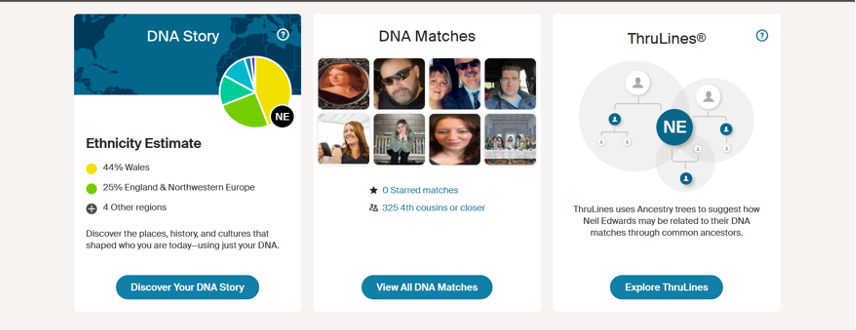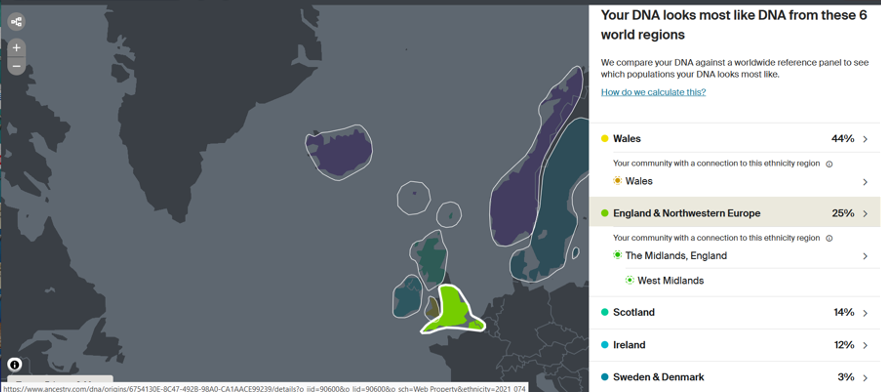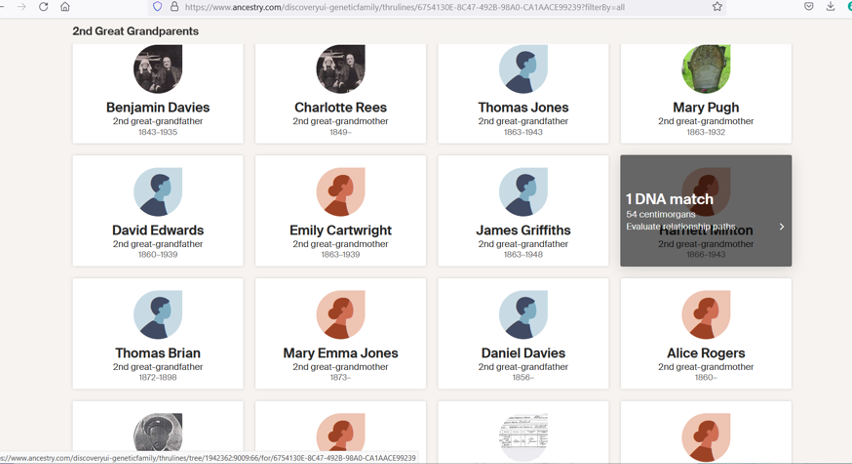Example of Ancestry DNA Results
Are you considering taking the Ancestry DNA test to find out more about your ancestry? In this article, we'll show you how to use Ancestry DNA and give you an example of how the DNA results look.
Some people may feel comfortable with the idea of having their DNA tested in order to get an ethnicity estimate from AncestryDNA while others may still be on the fence. There are a lot of people who have concerns regarding privacy and such and others who simply are not sure if it is worth the money.
Well, I began my family history research just over a decade ago and initially, I just worked with the records available on Ancestry. I knew they did the DNA testing and I wasn’t sure at first if it was for me.
Due to various reasons, researching my family tree was complicated and I couldn’t find out all the things I would have hoped based solely on the paper trails. It was, for this reason, I decided to stump up the cash and get myself that DNA test.
I can honestly say I do not regret the decision but do fully understand some people's reluctance. If you find yourself sitting on the fence when it comes to trying the AncestryDNA test please allow me to give you a little peek into what to expect from these tests. It may help you decide if it is worth your money and time to take the test.
Ancestry Results Example
Once you have taken the test and received your results you will be able to visit your Ancestry account to view and review the findings. When you log into your results you should be taken to a screen that looks something like the one below. In the interests of personal privacy, I have cropped out some of the information.

Your three options from this scene include viewing your ethnicity estimate, searching your DNA matches and looking at the Thrulines feature. Simply by clicking the blue buttons below each section it is easy to navigate to the required section. This is of course just the start of your genealogy DNA experience.
Ethnicity Estimate
The ethnicity estimate, also referred to by the site as your DNA Story, is generally speaking the main reason to decide to take this test with AncestryDNA. This is an immensely fun feature that really gives you an understanding of your potential ethnic background.
As you likely notice from the picture, my own ethnicity is solidly focused around England and Wales but your own may be far more diverse and potentially surprising. When I first tested almost 10 years ago there was a 1% Native American result in the mix but that has since disappeared.
The fact that I at one time was assessed as having potential Native American DNA stands as a testament to the growing accuracy of the test itself. As Ancestry’s database expands and more and more data is collected they are gradually refining their ethnicity regions.
As part of the DNA Story, you can find out a little information about the individual regions that you match including some geographic and historic details. These can really help us understand the people we came from historically. As an example, my solid Britishness likely means my ancient ancestors were Celts, Romans, Germanic tribes and the Norman French.
Depending on the specific regions you match with in your test you may also discover when your ancestors may have left their homeland to come to the area you now live. Migration patterns are included where applicable with a little history on why mass groups of people may have left.
So okay, let's take a closer look at the actual ethnicity estimate itself. As you will notice it lists the regions that you match from highest to lowest. In this case, they estimate that I am around 44% Welsh which based on my family tree is extremely accurate as my paternal grandfather was born in Wales. I also have known Welsh ancestors on my maternal side.

The next highest estimate was 25% English and as you may notice it specifically mentions the West Midlands. This again is accurate based on my family tree research with my family on both sides being from the counties of Radnorshire (Wales) Herefordshire (England) and Shropshire (England) as far back as I can trace.
There is a drawback regarding the ethnicity estimate, however, which essentially is not really a fault of the test itself. The issue is that due to the nature of DNA the further we go back in our family tree the more likely it is we find a direct ancestor with whom we share no DNA.
Random Recombination of DNA through Generations means that we could potentially not inherit any genetic material from an ancestor as close as a great-great-great-great grandparent. This may mean that we do not have any ethnicity markers from that ancestor so we might be missing an important element to our makeup.
Aside from this problem caused by DNA inheritance which the test is powerless to fix, the ethnicity aspect of the DNA is immensely fun, informative and potentially a great help in your research.
DNA Matches
This section essentially offers a list of other AncestryDNA users with whom you share segments of the same DNA. The length of these common segments of DNA is measured in centimorgans (cM). Each human possesses 6800 cMs of DNA length so the closer the centimorgan match you have with someone is to this amount the more you are related genetically.

As an example, a child would match their parent at around 3400 cM because they have received half of their DNA from their parent. Any close family matches on this list will likely be family members that you knew had tested already. Although there is always the possibility of a surprise family member you did not know about.
You will note each user has a name attached to their DNA. Ancestry will give you an estimate of what possible relationship there is between you and also show how many centimorgans you share. These matches may have trees attached to their DNA profile which you can review to try and locate the match or they may have a private, unmatched or no tree at all on the site.
It is from this section that you can try finding out more about your DNA matches which depending on their privacy settings may be easy or impossible. You have the option to try and message matches with questions that they may or may not respond to.
This is a good section of the DNA results as it can really help assist you with your research. There are a number of tools in this section that allow you to sort matches and in doing so locate matches that may belong to a family line you know little about.
I will not go in depth into the research processes you might be able to use in the DNA matches section because that would be a lengthy post all to itself. Rather, I will simply assure you that this is a very worthwhile section for your genealogy research.
Thrulines
Thrulines is an interesting tool that really has a mixed response with amateur and professional genealogists alike. Using algorithms and comparing people's trees AncestryDNA has created a tool that estimates your exact relationship to certain DNA matches.
This can at times be accurate and often leads to the discovery of a common ancestor. There is however an element of potential inaccuracy as the algorithms will sometimes make assumptions as to how a missing link is connected to a family.
Distant thruline connections really need to be scrutinized before you can accept them as likely correct. This not only requires that you are confident that the information in your tree is accurate but also that you are confident that your matches tree is well researched and accurate as well.
As you will note the Thrulines has all of your direct line ancestors listed with their own clickable box. Hovering over the box with your cursor will tell you if you match anyone else who the system believes may be descended from that same person.

I have used this tool to confirm matches with cousins who had well fleshed out and accurate trees and also found inaccuracies that could not be solved with other potential matches. This is not a terrible feature but it is certainly one that requires some level of skepticism.
You can use Thrulines to potentially make some major breakthroughs in your research but never assume that it is 100% accurate. Falling into the trap of taking it all at face value can lead to major mistakes in your tree and we do not want that.
How Many Matches Do You Get with AncestryDNA?
This is a very case by case dependent number and can be affected by any number of circumstances. I am from England and as of March 2022 have 325 4th cousins or closer matches. This is in contrast to my American wife who has over 1000 4th cousins or closer. There are even more 5th-6th cousin matches in the lists as well.
The exact number is really based on how many of your close and distant family members have tested on AncestryDNA. This can vary on the general size of your family, where your family is from and whether your cousins make their DNA profiles public.
Generally speaking, you get a few hundred fourth cousins or closer with numerous more distant cousins as well. It is also worth checking back regularly as the number does slowly creep up from time to time as more and more people take the tests.
Conclusion
In my personal family tree research circumstances the AncestryDNA test has helped me answer some important mysteries. It is a well laid out aesthetically pleasing results system with multiple uses for your research.
There is always the concern regarding your DNA security with regards to law enforcement and I fully understand the reticence of some people to test. If you can get beyond those concerns however it is definitely worth the money to give this test a go. You might find out some amazing things about your family that you did not know.
Link To or Reference This Page
We spent a lot of time downloading, cleaning, merging, and formatting the data that is shown on the site.
If you found the data or information on this page useful in your research, please use the tool below to properly cite or reference Name Census as the source. We appreciate your support!
-
<a href="https://namecensus.com/blog/example-of-ancestry-dna-results/">Example of Ancestry DNA Results</a>
-
"Example of Ancestry DNA Results". NameCensus.com. Accessed on May 7, 2024. https://namecensus.com/blog/example-of-ancestry-dna-results/.
-
"Example of Ancestry DNA Results". NameCensus.com, https://namecensus.com/blog/example-of-ancestry-dna-results/. Accessed 7 May, 2024
-
Example of Ancestry DNA Results. NameCensus.com. Retrieved from https://namecensus.com/blog/example-of-ancestry-dna-results/.
